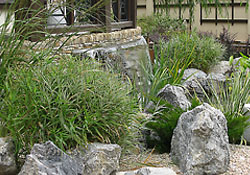|
|
||||||||||
| Motives of fine gardening Garden practicum Weather saying calendar Zests Views SiteMap Nursery KAVERINO |
Design process
A sample of Paysage Studio works
A customer often treats landscape projecting as a non-obligatory phase of garden layout and believes that he or she can cut down on it. However, not a single landscape company will take on improvement and territory planting without having a bundle of project documentation.
As a rule project works account for 5% to 10% of landscape construction cost. This spending allows not only to establish priorities of your future garden style, i.e. to imagine how it will look like, but also to calculate precisely expenses of construction, building material and planting stock; this work will greatly reduce the time of project implementation, save from errors and miscomprehension. Let alone that preliminarily projected garden is better thought-out from the point of view of its viability and decorativeness.
Several main stages can be emphasized in projecting:
- Pre-projecting consulting and investigation
- Pre-design
- Preparation of main project documentation
- Preparation of additional project documentation
Pre-projecting investigation
Pre-projecting investigation includes as follows:
- Company specialist’s visit for esthetical view and analysis of such aspects as territory, general condition of the site, peculiarities of site relief and existing verdure; identification of architectural style of the house and other buildings; making photos of the site; discussion of customer’s own planning; preparing design task to include all customer’s wishes and preferences; preliminary estimation of project works.
- Making photos of territory to prepare general location plan (connection with buildings, verdure, and utility lines, detection of relief elevations and deviations), examination of site insolation, preliminary evaluation of morphological tempers of the land.
- In case of rugged relief with great elevation changes – more detailed topographic plotting is needed for further leveling operation and mass haul calculation.
- In case of natural canopy cover, especially on timberland, landscape taxation is carried out to plot each woody plant. Data of species and varieties, habitus, quantity and diameter of trunks, mechanical damages, degree of injuries by parasites and diseases if exist, evaluation of viability and decorativeness is entered in inventory list of lignosa and shrub. Taxation analysis will define actions for further plant treatment, such as cure, cutting, removing.
If woodlots occupy vast territory, such detailed inventory is conducted only on important patches (near buildings, hypothetical functional zones). Other plantings are estimated according to their general condition.
At this stage any customer’s documentation may considerably facilitate landscape designer’s work, reduce the time for making a situation plan as well as improve its accuracy. For instance, a residential building plan gives an opportunity to define function of inner rooms with windows directed into the garden. A plan of hidden communication lines will deliver from mistaken planting of large-sized trees near electric cables, water pipelines and sewage system; location of wells doesn’t always reveal the direction and occurrence depth of these communications.
If there is heavy texture, insignificant depth of humus (that is wide-spread phenomenon in Moscow’s suburbs) or soil degradation after cottage building, the total replacement of fertile layer in holes will be offered. Sizes of the latter are calculated from increased needs of a decorative mature plant as well as grass covering. As a rule, providers supply soil with its analysis.
Chemical analysis will have to be done if a landscape firm doesn’t have it or the site soil has significant depth of humus and favorable structure for planting. It is aimed at estimation of fertility and potential soil enrichment, further correction of soil acidity by liming, improvement of soil structure, and revelation of toxicity.
Soil analysis has to comprise at least five categories which give you information about its general condition:
- Actual acidity (level рНKCl)
- Total nitrogen (N)
- Labile phosphorus (P2O5)
- Exchange potassium (K2O)
- Biological test of total toxicity.
Pre-design
After shooting the territory, making general location plan, and gathering information needed for landscape projecting, two variants of drafts are made.
Drafts making is a very important stage, because it comprises an idea of the future garden, of its style or, in other words, of its essence. At this stage the customer makes a decision: how the future garden will look like, to what extent it will be decorative, convenient, and functional.
The draft is a top view plan of site territory on which projectible paths, yards, location of small architectural forms, pools, rockeries, and green planting (trees, flowers, and lawn) are plotted. Drafts are provided with inscriptions or explications. If any element demands explanations, its perspective sketch or scheme may be enclosed to the draft.
After thorough examination of drafts and discussion with family members, the next meeting with a designer is arranged. All their comments and wishes are told to him or her. They will form the basis of the consolidated sketch. It may optionally include drawings of viewpoints. This sketch is also discussed; pavement, stones for retaining walls, pools, and rockeries, planting stock of trees and bushes are chosen.
Customer’s remarks are taken into account while preparing the main project documentation.
Main project
The main project documentation, or general plan, is based on the draft asserted by the customer. It includes the following documents:
- Dendro-plan with assortment register, floristic legend (illustrations, habitus, and description of varieties)
- Planting plan overlapped with dendro-plan
- Layout drawing
- Estimated cost of landscape works
- Explanatory note, including schemes of structural components (roads, yards, retaining walls, rockeries, parterres), planting and treatment recommendations.
Additional project documentation
As a rule additional works are needed for implementation of designer’s ideas and for garden functioning as a combined system. Among them are drainage excavation and automatic sprinkling set-up that also demand projecting. They are based either on previously projected scheme of plantings (e.g. automatic sprinkling) or on correction of this scheme (e.g. drainage), because large-sized trees must not be planted within a radius of 2 meters of drain lines.
Decorative elements such as parterres, rockeries, pools, and small architectural forms also demand detailed projecting with an appeal to different specialists: designers, biologists, engineers, and technologists. For example, if you want to lay out a parterre, perennials should be selected by decorative properties, height, colour, blooming period, size of stalks and flowers, attitude to light conditions and soil moisture. Creation of bog gardens and herbal gardens require special knowledge of plant material. For making a pool it is necessary to have its plan, scheme of material layering, calculation of pumping and filtering equipment that depends on pondage and pattern of its utilization.
Transformation of rugged relief demands leveling operation.
As a result the following documents can be enclosed to the main project:
- Detailed plans of parterres, rockeries
- Layout of garden lamps
- Project of drainage (if necessary)
- Project of automatic sprinkling
- Project of a decorative pool
- Engineering documentations of small architectural forms
- Project of leveling operation
PhD, Senior Teacher at the English Language Department for the Faculty of International Relations of Saint-Petersburg State University
|
|
|
| © Paysage – Landscape Art Studio |

